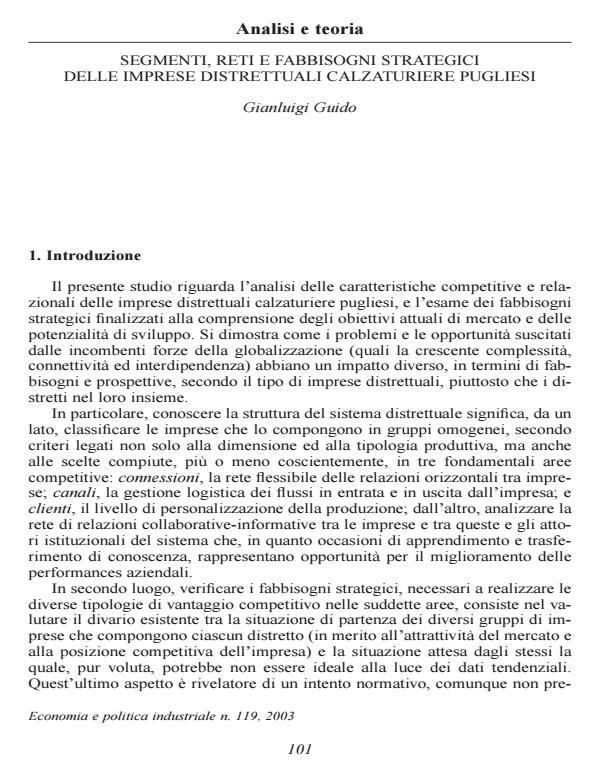Segmenti, reti e fabbisogni strategici delle imprese distrettuali calzaturiere pugliesi
Journal title ECONOMIA E POLITICA INDUSTRIALE
Author/s Gianluigi Guido
Publishing Year 2004 Issue 2003/119
Language Italian Pages 36 P. File size 178 KB
DOI
DOI is like a bar code for intellectual property: to have more infomation
click here
Below, you can see the article first page
If you want to buy this article in PDF format, you can do it, following the instructions to buy download credits

FrancoAngeli is member of Publishers International Linking Association, Inc (PILA), a not-for-profit association which run the CrossRef service enabling links to and from online scholarly content.
This paper presents an empirical research focused on the footwear firms of two districts in Puglia, Southern Italy (Casarano and Barletta). It aims to show how problems and opportunities set by the growing forces of globalization have a different impact, in terms of strategic requirements, according to the type of district firms, rather than to the district as a whole. Two research objectives are, thus, pursued: firstly, to classify footwear district firms according to their structural and competitive characteristics, as well as their level of relationships (in terms of share of information and cooperation) with the other actors of the network. Secondly, to analyze, according to each cluster of district firms, the strategic requirements defined as gaps between their present competitive situation and the potential one in terms of competitive advantages and future market attractiveness. By using a cluster analysis, nine different segments of district firms were found according to structural and competitive characteristics. For each cluster, collaborative and informative relationships were measured, using local and global indexes of network analysis. Finally, a portfolio analysis was carried out, using the McKinsey matrix, to determine the strategic requirements of each cluster of district firms. Results show that some clusters of medium-sized footwear manufacturers and suppliers of accessories and shoes components have promising potentialities, whereas some other clusters of very small and large-sized manufacturers of the same district are in deep crisis, mainly due to the fragmentation of the production process, high labor costs, and low product differentiation in comparison to new competitors from East Europe and Far East. Normative and marketing implications were discussed for the strategic policies and perspectives of different clusters of district firms. L’Autore ringrazia la dott.ssa Adriana Marraffa per la collaborazione nella raccolta, analisi e discussione dei dati della network analysis.
Gianluigi Guido, Segmenti, reti e fabbisogni strategici delle imprese distrettuali calzaturiere pugliesi in "ECONOMIA E POLITICA INDUSTRIALE " 119/2003, pp , DOI: